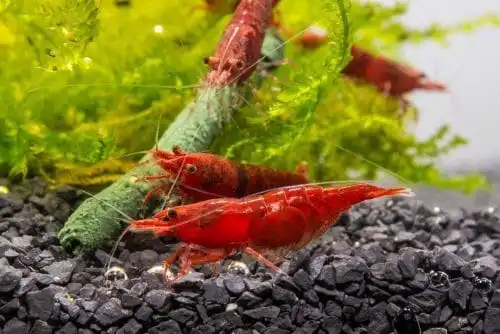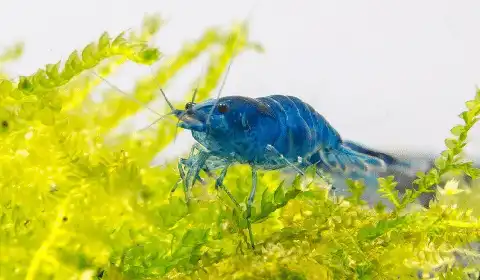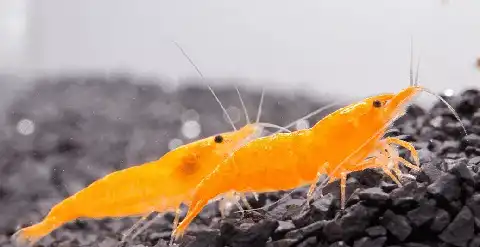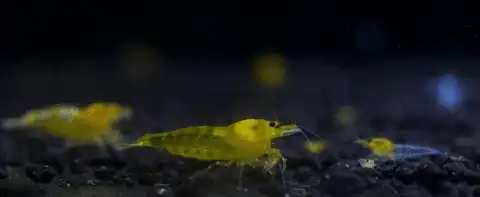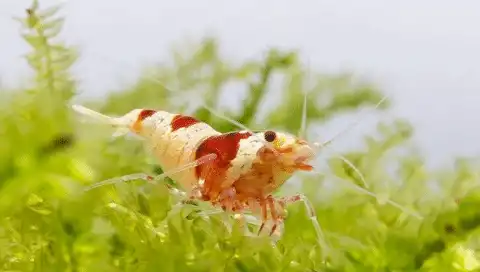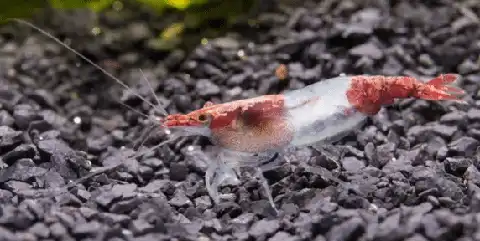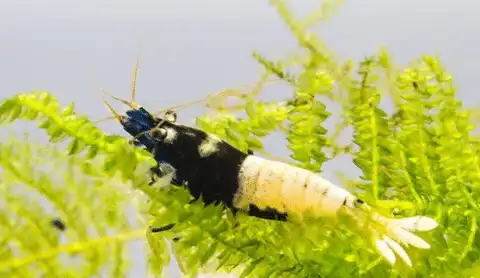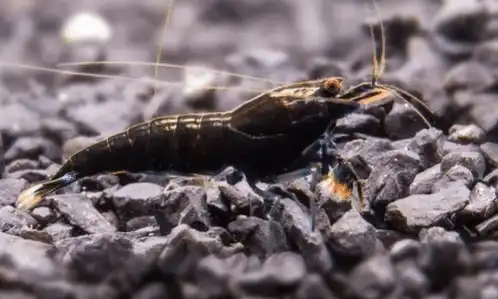Thank you for visiting! By the way… any links on this page that lead to products on Amazon and other stores/partners are affiliate links Aquarium Store Depot earns a commission if you make a purchase.
The aquarium hobby isn’t only about keeping tropical fish. Inverts like freshwater shrimp have become incredibly popular in the last few decades, and today there is an amazing variety of shrimps available.
In this article, I’ll be introducing you to 15 amazing shrimp types, and covering the basics of shrimp keeping to get you started.
So let’s get into the world of fascinating dwarf shrimp!
What Are Aquarium Shrimps?
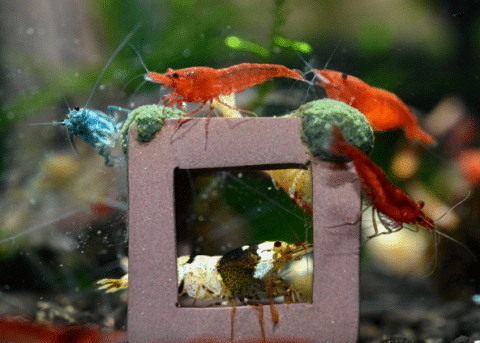
Freshwater aquarium shrimp are tiny crustaceans from the Atyidae family. Although there are many different colors available, most of them have been produced through selective breeding and there are just a few very popular species.
The 3 most commonly kept groups of freshwater aquarium shrimps are:
- Caridina species like the Taiwan bee shrimp
- Neocaridina species like the cherry shrimp
- Palaemonetes species like the ghost shrimp
Other freshwater shrimp types that are kept include:
- Atyopsis species like the bamboo shrimp
- Atya species like the vampire shrimp
- Macrobrachium species like the Indian whisker shrimp
Neocaridina vs Caridina
The Neocaridina and Caridina genera are the two most popular aquarium shrimp, and they have been bred into an amazing variety of colors and patterns. Apart from their different color patterns, these freshwater shrimp look very similar, and you need a very well-trained eye to tell them apart based on their body structures.
Nevertheless, these animals come from two distinct genera and cannot breed together. They also have pretty different needs which makes it very important to know exactly which kind of shrimp you are caring for.
The Neocaridina genus includes very popular dwarf shrimp species like red cherry shrimp, babaulti shrimp, and snowball shrimp. Neocaridina species are ideal beginner shrimps that tend to be easy to care for and breed.
Caridina shrimp are better for more experienced shrimp keepers. These awesome animals include freshwater shrimp species like the Sulawesi shrimp/cardinal shrimp.
Top 15 Freshwater Aquarium Shrimp Types
Now that you know a little more about the different types of freshwater shrimps, it’s time to get into the fun stuff, and get to know the best-looking and most useful shrimp types for your tank!
For each freshwater shrimp species I’ll be listing the following important care information that you need to know:
- Species
- Difficulty Level
- Adult Size
- pH
- TDS
- GH
- KH
- Diet
- Difficulty to breed
- Gestation Period
- Planted tank suitability
Below is a video from our YouTube Channel. We go into more detail in the blog post below. If you like our content, be sure to subscribe to us on YouTube where we post new videos every week!
So let’s meet some interesting inverts!
1. Fire Red Cherry Shrimp
High quality Cherry Shrimp can now be shipped directly to your door! These premium quality cherry shrimp are a great way to stock your tank!
- Shrimp Species: Neocaridina davidi
- Difficulty Level: Easy
- Adult Size: 1-1.25 inches
- pH: 7-8
- TDS: 200-300ppm
- GH: 4-8dGH
- KH: 3-15dKH
- Diet: Omnivorous
- Difficulty to breed: Easy
- Gestation Period: 30 days
- Planted tank suitability: Yes
Number one on this list has to be the fire red cherry shrimp. This is a really popular freshwater shrimp with deeps. This cherry shrimp that is easy to care for and actually helps maintain your tank!
The fire red cherry shrimp is the ideal choice for beginners because they are hardy and easy to feed and breed. These active shrimp are very entertaining and work great in a planted nano tank. Neocaridina davidi is an adaptable species that can be kept in temperatures between about 60°F and 85°F.
2. Amano
Best For Planted Tanks!
When it comes to keeping a healthy planted aquarium, Amano Shrimp are the best. These hard-working crustaceans will dutifully wipe your plants and rockwork clean of algae. Their appetite for different types of algae that can't be matched by other shrimp breeds!
- Shrimp Species: Caridina multidentata/ C. japonica
- Difficulty Level: Easy
- Adult Size: 1.5-2 inches
- pH: 6.5-8
- TDS: 80-450 ppm
- GH: 1-15dGH
- KH: 1-10dKH
- Diet: Omnivorous
- Difficulty to breed: Easy
- Gestation Period: 30 days
- Planted tank suitability: Yes
The Amano shrimp was introduced to the hobby by Takashi Amano way back in the 1980s. Since then, these excellent inverts have been a staple in the planted tank hobby because they are algae eaters which makes them a great part of any clean-up crew. They are one of the few shrimps that are known for eating black brush algae.
Amano shrimps are a little larger than cherry shrimp and tend to be relatively long-lived. While they might not have the same bright colors as some of the other Caridina species, The ‘natural’ look is great for nature aquariums. They also will only breed with the same species and cannot successfully reproduce in freshwater only!
3. Blue Dream
The Blue Dream Shrimp is a great shrimp if you are looking for blues in your aquarium. Also a hardy shrimp!
- Shrimp Species: Neocaridina davidi
- Difficulty Level: Easy
- Adult Size: 1-1.25 inches
- pH: 7-8
- TDS: 200-300ppm
- GH: 4-8dGH
- KH: 3-15dKH
- Diet: Omnivorous
- Difficulty to breed: Easy
- Gestation Period: 30 days
- Planted tank suitability: Yes
Blue animals can be pretty hard to find for freshwater aquariums. Fortunately, the blue dream shrimp is an excellent exception!
These unique and eyecatching forms of the popular cherry shrimp are just as easy to care for but provide a different dimension of color. These inverts provide a number of benefits for the health of your aquarium, just like regular cherry shrimp.
4. Sunkist Orange
These orange shrimp make great additions in a shrimp only or freshwater planted tank. Low maintenance and easy to care for!
- Shrimp Species: Neocaridina davidi
- Difficulty Level: Easy
- Adult Size: 1-1.25 inches
- pH: 7-8
- TDS: 200-300ppm
- GH: 4-8dGH
- KH: 3-15dKH
- Diet: Omnivorous
- Difficulty to breed: Easy
- Gestation Period: 30 days
- Planted tank suitability: Yes
The Sunkist orange is another color variant of Neocaridinia davidi, and these guys really know how to brighten up an aquarium! These shrimp look amazing in planted tanks with a dark substrate that makes their colors pop.
They are also known as orange sakura shrimp, and they are pretty hardy and low maintenance. These shrimp are another great choice for beginner shrimp keepers.
5. Yellow Goldenback
The goldenback offers a yellow shrimp with a translucent line on the middle of their backs. They look amazing in dark backgrounds
- Shrimp Species: Neocaridina davidi
- Difficulty Level: Easy
- Adult Size: 1-1.25 inches
- pH: 7-8
- TDS: 200-300ppm
- GH: 4-8dGH
- KH: 3-15dKH
- Diet: Omnivorous
- Difficulty to breed: Easy
- Gestation Period: 30 days
- Planted tank suitability: Yes
The yellow goldenback shrimp is another form of the cherry shrimp. In terms of color, these inverts pack a lot of punch for such a small animal. These shrimp have a solid gold-yellow line along their back from their nose to their tail, and the rest of the body is a translucent yellow color.
6. Tangerine Tiger
This variety of shrimp offers an orange color with black strips that resemble a tiger. Beginner friendly and will not breed with neocardina shrimp
- Shrimp Species: Caridina serrata
- Difficulty Level: Moderate
- Adult Size: 1-1.5 inches
- pH: 6.5-7.8
- TDS: 100-250ppm
- GH: 5-6dGH
- KH: 0-5dKH
- Diet: Omnivorous
- Difficulty to breed: Easy
- Gestation Period: 30 days
- Planted tank suitability: Yes
The tangerine tiger is a relatively hardy Caridina species. Like the popular Amano shrimp, these crustaceans make a great addition to your tank as a dedicated member of the clean-up crew.
These shrimp are a great starter for keepers who are new to the world of Caridina, and they can even be mixed with Neocaridina species because they will not breed together.
7. Crystal Red
A beautiful looking freshwater shrimp that is more on the difficult side of keeping. A hallmark among shrimp hobbyists
- Shrimp Species: Caridina cantonensis
- Difficulty Level: Moderate-Advanced
- Adult Size: 1-1.5 inches
- pH: 6-7.5
- TDS: 100-200ppm
- GH: 4-6dGH
- KH: 0-2dKH
- Diet: Omnivorous
- Difficulty to breed: Easy
- Gestation Period: 30 days
- Planted tank suitability: Yes
The crystal red shrimp is cool-water shrimp that is most at home in water between 64°F and 76°F. They were originally bred from the Taiwan Bee shrimp and their bold colors are reminiscent of the koi fish.
To achieve these colors, they have been selectively bred, and today they are available in a variety of grades. The crystal red shrimp is one of the best-looking inverts in the hobby, but they do require more experience and they tend to be fairly expensive.
8. Green Jade
The Green Jade Shrimp is the best shrimp to buy if you are looking for striking green colors
- Shrimp Species: Neocaridina davidi
- Difficulty Level: Easy
- Adult Size: 1-1.25 inches
- pH: 7-8
- TDS: 200-300ppm
- GH: 4-8dGH
- KH: 3-15dKH
- Diet: Omnivorous
- Difficulty to breed: Easy
- Gestation Period: 30 days
- Planted tank suitability: Yes
The green jade shrimp is a beautiful color variant of the popular cherry shrimp. They have very similar markings to the yellow goldenback, with the same ‘racing stripe’ along their back. They differ in their amazing jade-green body color.
9. Blue Bolt
The blue bolt shrimp is a Caridina shrimp that offers blue and white colors
- Shrimp Species: Caridina cantonensis
- Difficulty Level: Moderate-Advanced
- Adult Size: 1-1.5 inches
- pH: 5.6-6.2
- TDS: 100-200ppm
- GH: 4-6dGH
- KH: 0-2dKH
- Diet: Omnivorous
- Difficulty to breed: Easy
- Gestation Period: 30 days
- Planted tank suitability: Yes
The blue bolt shrimp is a stunning, but difficult to keep, cross between the Taiwan Bee shrimp and the crystal black shrimp. These eye-catching shrimp have speckled whitish bodies, with blue heads and reddish eyes.
10. Red Rili
A striking red and white shrimp that is hardy and easier to care for
- Shrimp Species: Neocaridina davidi
- Difficulty Level: Easy
- Adult Size: 1-1.25 inches
- pH: 7-8
- TDS: 200-300ppm
- GH: 4-8dGH
- KH: 3-15dKH
- Diet: Omnivorous
- Difficulty to breed: Easy
- Gestation Period: 30 days
- Planted tank suitability: Yes
The red rili shrimp is a great option for inexperienced keepers who want the red and white colors of something like a crystal red. As a product of selective breeding of the cherry shrimp, they are relatively hardy. Unlike the more expensive crystal shrimp, red rili shrimp have more translucent bodies.
11. Glass (Ghost)

- Shrimp Species: Palaemonetes sp.
- Difficulty Level: Easy
- Adult Size: 1-1.5 inches
- pH: 7-7.8
- TDS: 150-200
- GH: 3-15dGH
- KH: 3-15dKH
- Diet: Omnivorous
- Difficulty to breed: Easy
- Gestation Period: 3 weeks
- Planted tank suitability: Yes
Glass shrimp, which are also known as ghost shrimp, are native to North America. Ghost shrimp are often sold at your local fish store as feeder animals for larger fish, but they actually make awesome pets.
There are a few different species of shrimp known as ghost shrimps, and they get their name from their translucent body. Buying these shrimp can be a bit of a gamble because some ghost shrimp species are actually adapted to brackish or salt water.
12. Chocolate
- Shrimp Species: Neocaridina davidi
- Difficulty Level: Easy
- Adult Size: 1-1.25 inches
- pH: 7-8
- TDS: 200-300ppm
- GH: 4-8dGH
- KH: 3-15dKH
- Diet: Omnivorous
- Difficulty to breed: Easy
- Gestation Period: 30 days
- Planted tank suitability: Yes
The chocolate or black rose shrimp is a really attractive but understated color morph of the cherry shrimp. Their color varies from an almost red-brown color to brown speckled over a clear yellow body. These shrimp are easy to care for and will be a great addition to a planted tank.
13. Black Pinto
A unique Caridina shrimp with a black and white body and blue highlights. Requires excellent water conditions to keep.
- Shrimp Species: Caridina cantonensis
- Difficulty Level: Moderate-Advanced
- Adult Size: 1-1.5 inches
- pH: 6-7.5
- TDS: 100-200ppm
- GH: 4-6dGH
- KH: 0-2dKH
- Diet: Herbivorous
- Difficulty to breed: Easy
- Gestation Period: 30 days
- Planted tank suitability: Yes
The black pinto shrimp is a selectively bred variant of the bee shrimp. These stunning inverts are best suited for more experienced shrimp keepers because they are sensitive and require excellent water conditions.
14. Black King Kong
An all black shrimp. A rare shrimp that requires extra care to keep
- Shrimp Species: Caridina cantonensis
- Difficulty Level: Moderate- advanced
- Adult Size: 1-1.5 inches
- pH: 5-6
- TDS: 100-200 ppm
- GH: 4-6dGH
- KH: 0-2dKH
- Diet: Herbivorous
- Difficulty to breed: Easy
- Gestation Period: 30 days
- Planted tank suitability: Yes
These incredibly marked inverts are also known as the panda shrimp or black king kong pandas. They are rare and high-end animals, that come at a cost, but they’re worth it if you ask me! If you’re an experienced shrimp keeper, this type is definitely worth considering.
15. Extreme Wine Red
A very popular shrimp that is best suited for experienced shrimp keepers. Dark red and white coloration
- Shrimp Species: Caridina cantonensis
- Difficulty Level: Moderate- Advanced
- Adult Size: 1-1.5 inches
- pH: 5-6
- TDS: 100-200ppm
- GH: 4-6dGH
- KH: 0-2dKH
- Diet: Herbivorous
- Difficulty to breed: Easy
- Gestation Period: 30 days
- Planted tank suitability: Yes
The extreme wine red shrimp has a very dark red body with lighter-colored legs, tail, and mouthparts. Like the black king kong, these valuable shrimp are descendants of the bee shrimp. The extreme wine red is a hugely popular but rare variant that is best suited to experienced aquarists.
Freshwater Aquarium Tank Setup
Shrimp have much the same needs as tropical fish when it comes to their tank set up. This means an adequately sized aquarium with a filter and a heater(in temperate climates) is necessary. Let’s take a look at how to create the perfect tank environment for your shrimp.
Tank Size
Shrimp are very small animals that contribute very little to the bio-load of an aquarium. For this reason, many shrimp keepers are able to maintain their shrimp in tanks of just a few gallons.
For beginners, however, a larger tank of 10 gallons or more will help in maintaining safe, stable water parameters. For the more sensitive Caridina species, a tank of 15-20 gallons is ideal.
Filtration
Filtration is vital in any aquarium, and freshwater shrimp setups are no different. The type of filter you run in your tank is important, however, especially if you are going to be breeding them.
Shrimp are not the strongest swimmers, and they love looking for new places to hide. This can mean trouble and they can easily be sucked into the intake of a power filter.
I would suggest a simple, air-powered sponge filter, although a hang-on back or internal power filter are also good options as long as you set up a prefilter sponge to keep your pets out of the intake. You can make your own prefilter sponge, or select a model that provides this option.
Flow rate is also important when selecting a filter for your shrimp tank. choosing a model that is designed for your tank size is very important, and an adjustable flow rate will help in keeping the current down.
Substrate
You can keep your shrimp on an inert substrate like sand or gravel. These are good options for non-planted tanks or setups with floating and epiphytic plants.
Active aquarium soils like Tropica Aquarium soil or UNS Controsoil are better options for heavily planted tanks with stem and rosette plants. These soils can also be helpful in buffering the pH and keeping it down to ideal levels.
A top grade planted tank substrate from Europe. More natural looking than ADA Soil
Live Plants
Freshwater shrimps do very well in planted tanks. Plants are very helpful for taking up excess nutrients, oxygenating the water, and generally improving water quality. If you’re new to growing live plants, I would suggest starting out with some easy to grow, low-light plants like:
Shrimp can, however, also be kept in high-tech, CO2-injected tanks, provided the gas is kept in the safe range of below 30 ppm.
Freshwater shrimp are very sensitive to copper found in some plant fertilizers. Keep this in mind when picking up any products for your plants.
Freshwater plants are a very common source of unwanted pests in the aquarium. Don’t be discouraged though, there are safe ways to green up your tank. I would suggest growing tissue culture plants to avoid introducing pests like planaria that can kill shrimp.
Water Parameters
When discussing the needs of freshwater shrimp (or any aquarium fish or plant for that matter), aquarists are most concerned with the following parameters:
- pH: The level of the alkalinity or acidity of the water.
- GH: A measure of dissolved salts (particularly magnesium and calcium) in the water
- KH: A measure of the carbonates and bicarbonates in the water. These affect the stability of the pH
- TDS: Total dissolved solids in the water, measured in parts per million
The only way to reliably monitor these parameters is to test them regularly.
Don’t sweat it, you don’t need a degree in chemistry for this. All you need is some simple test kits and a TDS meter to start out. They’re easy to use, and pretty fun too!
Readily available online, this TDS Meter is perfect for ensuring your levels are optimum for your shrimp
Water Quality
Together with the parameters listed above, there are some other chemicals found in your water that increase when uneaten fish food and waste accumulate. These are nitrogen compounds called Ammonia, nitrite, and nitrate. These parameters should be kept at:
- Ammonia: 0ppm
- Nitrite: 0ppm
- Nitrate:<20 ppm
These parameters can also be tested with your strip tests.
Before adding any shrimp to an aquarium, make sure it is fully cycled. A cycled aquarium will not produce any ammonia or nitrite as these harmful chemicals are converted into nitrates by beneficial bacteria.
If this sounds like a different language to you, go ahead and check out my article on fishless cycling.
A build-up of nitrates is to be expected in any tank. This is easily managed by performing regular partial water changes.
Care
Freshwater shrimp are generally easy to care for once you get the basics right. Shrimp are small, sensitive creatures, so slowly and carefully acclimating them to your tank is important. They are naturally social creatures, so make sure you keep them in a group of at least 10 or so.
Read on for some more important shrimp care tips.
Feeding
Shrimp are often kept as part of an aquarium’s clean-up crew. Some species like the Amano shrimp eat algae, and most shrimp will be more than happy to pick up the scraps of leftover fish food. Other freshwater shrimp species like bamboo shrimps, for example, are actually filter feeders.
In the right sort of setup, you might not have to feed your shrimp at all, but this is only really safe in mature established tanks that have some algae and other natural food sources.
In most cases, you’ll want to feed your shrimp a healthy, balanced diet. This can be done once per day, and remember to avoid overfeeding. Let’s take a look at some good freshwater aquarium shrimp food sources:
- Dennerle Shrimp King Food
- SL-aqua spinach powder
- Repashy gel food
- Blanched vegetables
Great For Freshwater Shrimp!
A color enhancing food for shrimp that will help intensify yellows, oranges, and most importantly red!
Maintenance
Shrimp need good water quality, and that means regular tank maintenance is necessary. You will need to perform a regular water change in the aquarium once a week or so to remove physical waste and reduce the nitrate levels in the water.
Great care is necessary since shrimp are small and can easily be sucked up by your gravel vacuum. A good workaround for this problem is to fit some fine mesh or stocking over the end of the gravel vacuum.
Be sure to treat the new water with a water conditioner and match the temperature to your tank water before adding it to your aquarium.
Tankmates
One of the most common questions aquarists ask is what kind of fish they can keep with their shrimp. Most shrimp make incredibly peaceful tank mates, but the challenge is that other animals tend to kill or eat them. Unfortunately, this means they don’t always work well in a community tank.
Freshwater snails are one of the best tank mates for your shrimp. I would suggest nerites and mystery snails because they will not breed out of control and compete with your shrimp for food resources.
There are very few fish that are completely shrimp-safe, especially if you are breeding your shrimp. Even adult shrimp can be picked at by surprisingly small fish. To be completely safe, a shrimp-only tank is your best bet.
Keeping fish with your shrimp is possible, however. Let’s take a look at a few potential peaceful fish tank mates:
- Nano livebearers like Endler’s livebearers
- Nano tetras like ember tetras
- Nano rasboras
- Some algae eaters like Otocinclus catfish and small plecos
When choosing fish as tank mates, it is best to assume that any species could be a potential threat to your baby shrimp. To be on the safe side, make sure you provide plenty of hiding spaces for your shrimp in case they need to retreat from their tank mates!
Breeding
Breeding your aquarium shrimp can be very easy (video source). The secret to success is simply to provide your shrimp with excellent water quality and the parameters they need to stay healthy. This is a lot easier to do with hardy Neocaridina shrimp species than the sensitive Caridina species.
Although the males tend to be a little smaller, sexing your shrimp is very difficult. For this reason, stating your shrimp colony with at least 10 individuals is recommended since this should provide you with at least a few of either sex.
If your shrimp are happy and healthy, you will probably be amazed to see tiny shrimp in the tank after a little while. Specialist baby shrimp foods are available to give the little ones the perfect nutrition.
Baby shrimp will often be eaten pretty quickly in a community fish tank. Providing them with plenty of cover in the form of floating plants is one way to minimize your losses, but it’s far better to grow your colony in a shrimp-only tank.
Avoid keeping different colors variants in the same tank if you’re going to be breeding your shrimp for specific colors. If they aren’t kept separately, they will breed together and lose their colors, producing pretty dull-looking offspring.
Where To Buy
If you’re looking for ghost shrimp, they can usually be found at your local fish store or even big box stores. For the higher quality and higher grade shrimp, I would check out an online fish store like Buce Plant. Not only do they stock an amazing range, but you can also pick up a couple of tissue culture plants from them at the same time to really get your tank started!
Buce Plant offers a wide variety of aquatic plants for sale. With one of the largest selections in the US, you will find what you need here. They are also a great source for freshwater shrimp!
FAQS
Which kinds are used in aquariums?
There is quite a variety of freshwater shrimp types available in the aquarium hobby. The most popular are certainly the Neocaridina and Caridina species.
Which kinds can be kept together?
Most of the dwarf freshwater shrimp can be kept together. It can be tough to match the parameters between the different types, however, so selecting a single species of shrimp is usually a safer bet for beginners.
Which are the hardiest?
The ever-popular cherry shrimp is considered by many aquarists to be the hardiest freshwater aquarium shrimp. Bamboo shrimp and glass shrimp are other close contenders.
Are they easy to keep?
Freshwater shrimp can be very easy to keep. For beginners, they are not as easy as some fish species, so be sure to get all your research done and your tank set up correctly before starting with shrimp.
What are some common types?
The freshwater shrimp that you are most likely to come across are cherry shrimp, Amano shrimp, and ghost shrimp. The various types of bee shrimps are also popular, and other shrimp species like bamboo shrimp are also available.
Final Thoughts
Freshwater shrimp are wonderful pets. They don’t need a lot of space, and they’re just as entertaining as fish (if you ask me anyway). The ongoing development of this side of the hobby is very exciting and I can’t wait to see which new breeds and species of shrimp will become available!
Which of the 15 shrimp types in this list do you like best? Let me know below!
- About the Author
- Latest Posts
I’m thrilled that you found Aquarium Store Depot! Here you’ll find information on fish, aquariums, and all things aquatics related. I’m a hobbyist (being doing this since I was 11) and here to help other hobbyists thrive with their aquariums! I adhere to a high quality Editorial Process and Review products with real life field usage and practical analysis.


